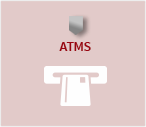








Central
bank
bank
The primary purposes of the central bank in the cash cycle relate to the executive management of the production, distribution, authenticity, quality, availability and destruction of notes and coins. The central bank may play both a direct physical and/or regulatory role in the cash cycle depending upon its remit and scale.


Cash
centres
centres
Cash centres can be operated by central and commercial banks, cash in transit or independent businesses. The specific focus of the centre will be determined by the priorities of the operating stakeholder, however they can all be considered a complex mix of industrial cash warehouse, bank and customer service centre working in a unique supply chain model.


ATMs
Automated devices (for dispensing, deposit accepting and recycling) have become the principal channel for cash moving between the bulk and consumer segments of the cash cycle. They generate such demand for product (e.g. notes) and services (CIT) that their influence over the modern cash cycle cannot be under-estimated.


Retailers
Even in the face of alternative electronic payment types, retailers' usage of cash increases in importance as they seek to achieve process, security and cash flow efficiencies through the innovative deployment of cash technologies in the front and back office. Changes made in the store environment ripple through the entire cash cycle as the commercial banks vie for the retailers' business.


Bank branch
Whilst the ATM provides the faceless efficiency, the bank branch still plays a significant role in many countries' cash cycles with the ‘walk-to-bank’ services of cash depositing and change collection a key interaction between commercial bank and retailer.


The flow of cash
The cash cycle possesses two unique characteristics as a supply chain. Firstly it is a fully recycling supply chain where the product (notes and coins) are used many times and over a lengthy period before exiting the cycle. Secondly the major stakeholders (Cash Centre, ATM, Branch and Retailer) all interact with each other, not just the adjacent link in the supply chain. These facets result in a complexity that is often unexpected and unpredictable.














